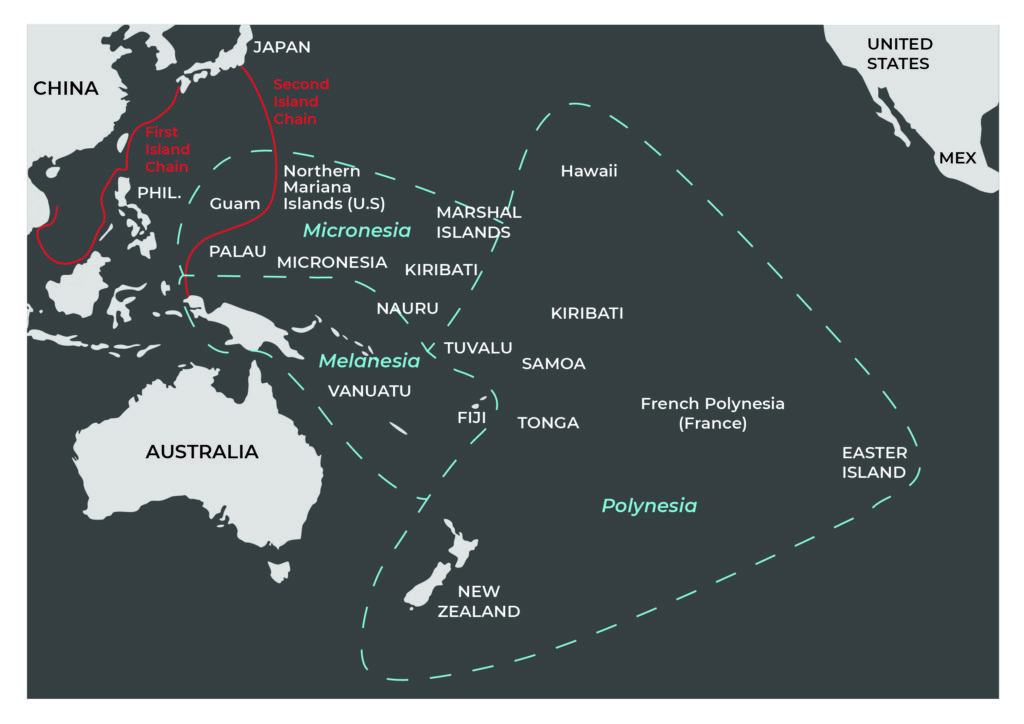Prologue
The People’s Republic of China has aggressively expanded its dominion across the Pacific. Xi Jinping seeks to cement his legacy by recapturing Taiwan and pushing the United States out. For over a decade now, China has used commercial deals and investments as cover to gain access to land and resources across the South China Sea in order to establish bases from which it can project power across the South China Sea. Having completed its near-total domination of the First Island Chain, China now seeks to expand into the Second Island Chain, America’s historic sphere of influence and home to a number of states under its protection.

Chapter 1: New Fangs
(Original Digital Art by Ari Basen using Midjourney)
INDOPACOM HQ, Pearl Harbor, Hawaii
Daniel Munemori, an NGA embed assigned to support INDOPACOM in Hawaii sat at his terminal flummoxed. For the past week, he had been trying to acquire updated satellite imagery around Micronesia in order to monitor the progression of Chinese construction in the Second Island Chain. He would get daily imagery but the pictures made no sense. One day there was a new radar tower and the next it would be gone; as if it had never been built. He would watch as an airfield would take shape and then as it neared completion, it would go back to just being a tropical forest. He cross-correlated this with commercial imagery and there was a pattern that anytime a new facility was completed at the Chinese-owned port on an otherwise uninhabited island in Micronesia, it would simply fall off imagery the next day.
Daniel pinged his friend and colleague Sarah Gunther from NSA-Hawaii.
“Are you still getting collect off the Chinese radars in Micronesia?”
“Yes.” She replied. “Normally they just operate them in long-range airborne surveillance mode, like for air traffic control, but every so often they make the mistake and use them in target acquisition mode.”
“Why would they install target acquisition radars where they do not have an ADIZ?” Daniel asks rhetorically about Chinese Air Defense Identification Zones.
“Because I would say we could expect one coming online pretty soon,” replied Sarah, not realizing it was a rhetorical question. “The target acquisition radars are consistent with what you would use to cue surface-to-air missiles.”
“But they don’t have SAMs in Micronesia… it’s just a ‘commercial refueling port’,” questioned Daniel.
“They bill it as a refueling station for their commercial fleet but it’s bullshit. It’s part of the long-term strategy of the Second Island Chain to push us out and dominate those shipping lanes and gas fields. And to defend those interests, they’re gonna up-arm them just like we saw in the Spratley’s over the past decade,” replied Sarah matter of factly.
“No shit. Of course, it’s going to be a base. Just like what they did with the port they built in Vanuatu which is now home to their nuclear subs,” retorted Daniel.
“So the issue I am having is that every time they put up a new object, be it a radar tower, a runway, even a container crane, it seems to disappear off imagery the next day. It’s like Groundhog Day.”
“That is most bizarre. Reminds me of someone playing a loop during a bank robbery,” mused Sarah. “The Israelis do that kind of magic trick when they bombed in Syria. They can make it seem like the radars for the S-300s are blank when the sky is actually filled with strike fighters. Cyber warfare FTW.”
“How would the Chinese make an entire airfield invisible to satellites? What do they have an island-sized invisibility cloak now?” asked Daniel.
“I assure you the facilities are still there. It is your satellites that are being tampered with. You are clearly being jammed in the visible light spectrum every time the bird passes over. They let you see it and then it’s gone right? They’re playing with you.”
“Obviously they could jam the birds but then we wouldn’t get any collection whatsoever and there would be all kinds of alarms going off at SPACECOM.”
“Daniel. Please. It’s the Chinese. They are far more subtle than the Russians. Perhaps I was imprecise with my diction in using the word ‘jam’ and I apologize. They are letting you see what they want you to see. They are teasing you with things being built and then they disappear. Clearly, they are injecting images into the birds themselves.”
“How do you come up with that? How is that even possible? So you’re saying that they somehow not only tracked the exact satellite passing overhead but then they hacked it and planted fake imagery in real-time every time it passed over?”
“You underestimate them, Daniel. When it comes to deception via deepfakes, they are most adept. You can use deepfakes to create any conceivable image or video or delete them. When I was attached to JSOC we would do this pretty regularly for security cameras to wipe any trace the team was there.”
“But that would require actively intercepting and injecting packets into the encrypted downlink.”
“What about the satellite bus itself where the images are taken and initially preprocessed before being transmitted? What is securing that?”
“Holy shit! You might just be right,” exclaimed Daniel
“I am always right, Daniel. It’s me,” concluded Sarah. “The issue here is that they know we’re looking in the visible light spectrum and thus they know how to outmaneuver us there. You need to try hyperspectral.”
“That sounds like some new party drug,” joked Daniel.
“I wouldn’t know. The last time I was at a party was in college and it was terrible and I avoid such useless affairs,” remarked Sarah.
“Live a little.”
“I prefer my sea turtles and kayaks, thank you very much,” said Sarah.
“This girl is impossible,” remarked Daniel to himself shaking his head on the other side of the computer screen.
“Anyways, all jokes aside, what is “hyperspectral” if not something from Power Rangers.”
“Almost all imagery satellites work within the visible light spectrum, focused predominantly on 3 color channels: Red, Green, and Blue. But instead of imaging a target in only one narrow part of the electromagnetic spectrum, you are putting together a composite picture of hundreds if not thousands of bands of EM radiation from infrared to ultraviolet and beyond to do your detection. From this hypercube, you can detect what is otherwise invisible to the naked eye. Materials absorb and emit EM radiation across many different frequencies and by measuring these emissions you can determine their composition. This is how we were able to determine the composition of distant stars and exoplanets despite having never been there.”
“Is this what you discuss on first dates? Because, well damn. You must be the life of the party,” teased Daniel.
“Focus Daniel. My dating life is none of your concern.”
“Grumpy old cat lady, or, well, sea turtle lady,” thought Daniel to himself.
“Request imagery from the LAPIS bird from NRO. They should be able to get you what you need. When you submit your request make sure to ask for scans throughout the infrared and ultraviolet spectrum.”
“Why infrared? Are we looking for explosions?”
“No. Rocket fuel absorbs light in the infrared spectrum. You were looking for SAMs, right?”
———————————————————————————————————————
After waiting through ten days of bureaucratic purgatory, Daniel finally got the NRO to take the hyperspectral imagery he needed. He drove out of Honolulu through the Moanalua Valley towards the east side of the island. He pulled into a nondescript office building next to a beach bustling with tourists admiring sea turtles and taking pictures for Instagram.
Daniel enters the NRO Hawaii ground station SCIF and is greeted by a Space Force IMINT cell chief Capt. Arthur McGovern.
“I am sorry for making you drive all the way out here, Mr. Munemori” apologized Capt. McGovern. “These datacubes coming off the HSI imagery are just too damn massive to send through standard channels.”
“It’s quite alright. The drive was lovely. Anything to get me off Pearl Harbor is welcome,” joked Daniel.
“So I understand that you have been having issues with electro-optical over Micronesia,” stated Capt. McGovern as the heavy SCIF door closed behind them, entering a windowless room whose only light came from the endless rows of project monitors.
“Yeah, it’s been so weird, I will watch them build a radar tower or a runway, and then when it completes, it just falls off imagery. You guys haven’t had any jamming right?”
“No sir. Our birds are responding fine. It is quite odd that your areas of interest would fall off like that. Almost like they’re purposely being wiped,” observed Captain McGovern.
“Sarah said the same thing,” bemused Daniel.”
“Dr. Sarah Gunter from NSA?” asked the Captain.
“You know her?” asked Daniel
“Oh yeah. She is a legend. I did a tour with her at Peterson. She is an absolute wizard with the collection of satellite communications” remarked Captain McGovern.
“I didn’t know she had a Ph.D. She never mentioned it or had it in her signature block,” said Daniel intrigued.
“She is rather humble in that respect I guess,” remarked the Captain. “But I know she definitely is a professor because she has a whole course on space-based cyber operations at the Air War College.”
“Yeah she suggested that the satellite imagery is being manipulated on the satellite buses themselves but I don’t know how you would do the diagnostics for that. Little hard to run Norton on a satellite orbiting at 17,500mph,” said Daniel.
“Well, after I get done showing you what we found, we can talk to the folks at Space Delta 6 in Colorado Springs but it might be a little late in the evening for them,” mentioned the Captain. “But you are definitely gonna enjoy what we have to show you today.”
“SSGT, can you please bring up the hypercube imagery for 57N VH 11507 62768.”
“Yessir, Micronesia coming right up.”
“So here you can see the island of Pohnpei and here is the city of Palikir which is the capital of Micronesia. See that building right there, the biggest in town? That’s the Chinese embassy. They may as well own the place,” explained Captain McGovern.
“Ok, can you switch over to the Ant Atoll? That is where the PLA has been building.”
“Yes. Here you have it in EO (electro-optical) and you’re right. Nothing there. But when we switch to Synthetic Aperture Radar, it’s all there. Radar sites, hangars, and even what look like missile launch tubes are buried in the sand. That’s what I love about SAR is that it can punch through atmospherics, forests, dust storms, and show me anything solid, anything buried. We used to use this a lot to find cave systems in Afghanistan being used by the Taliban.”
“Can you tell if they are loaded and armed?”
“Of course. That’s the beauty of the HSI imagery. We ran scans through UV to NIR looking for the tell-tale absorption spectra of ammonium perchlorate which is the primary oxidizer for solid rocket fuel. See those bright blue patches in the false color? That is picking up the oxidizer.”
“And you can detect specific chemical compounds from space with this?”
“Your tax dollars are hard at work my friend,” joked Capt. McGovern. “But wait there’s more.”
“I feel like your television salesman for OxyClean,” chuckled Daniel.
“So when we ran our scans in long-wave infrared we detected boron. Boron is not normally used for rocket fuel because it’s highly temperamental and very hard to ignite but once it does, it’s extremely powerful. The backend of LAPIS takes these 3D datacubes and uses AI to simulate the materials at a chemical level. It essentially creates a ‘digital twin’ of the missile and its components.”
“Now that is cool,” exclaimed Daniel. You can just do a few passes over it with a satellite and now you can simulate it both in 3D physically and the internal chemical structure?”
“Yes, you can thank the brainiacs at DARPA and Sandia National Labs for this one,” remarked Captain McGovern.
“So we take the SAR scans and combine them with the HSI and we can now have a pretty good 3D model of the missile and its launcher. Switching to false colors highlights the various chemical components. The blue again is the oxidizer then the yellow is the boron carbide propellant and the green is the binding agent. We ran this through a thermodynamics engine to simulate burn patterns and they have apparently significantly modified and optimized the boron-carbide propellant. Like yes, it normally burns really well, but the thermal efficiency they are getting off this, we have never seen this before. I checked this with NASIC and DIA MSIC and they too have never seen a rocket engine this thermodynamically efficient.”
“So what does it mean? Does it burn better? It burns faster?” asked Daniel.
“Actually the burn rate is optimized to improve the range. It’s like driving at 55mph on the highway, it optimizes speed and fuel efficiency. I am not sure how they finally solved the chemical structure for this one. We have been trying to tame boron fuels since the 1940s with the first ballistic missiles. They must have used reinforcement learning or something to iterate through thousands of molecular combinations for this. It’s beyond that of a human or even a team of humans to get down to that level of detail.”
“Ok, so what does this mean in the real world for those of us who aren’t rocket scientists?”
“It vastly improves the range of the missile while still being able to cruise at Mach 10. They took their hypersonic anti-ship cruise missile and turned it effectively into a ground-launched cruise missile with the range of an intermediate-range ballistic missile.”
“Traveling at those speeds at such a flat trajectory, damn near impossible to stop,” realized Daniel. “What could it possibly hit?”
“So we estimate a range of about 5500 km, nearly 5x their YJ-21s currently deployed. Traveling at Mach 10 from that launch position, they could hit here, Hawaii, in under 30 minutes. They could knock out INDOPACOM before we even get to the fight.”
“Oh my God,” exclaimed Daniel, taking a seat, wide-eyed with the realization. “We need to inform the Admiral… we need to inform everyone. This is a level 1 priority intelligence requirement.”
“No. This is when you wake up the POTUS. I think you may be on a flight to the Pentagon with this one.”









0 Comments